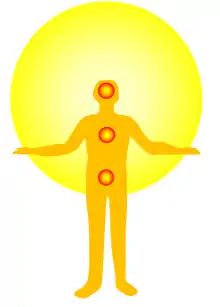Dantian
Dantian (chinesisch 丹田, Pinyin Dāntián, W.-G. Tan-t'ien, Jyutping Daan1tin4 – „Zinnoberfeld“) ist ein Begriff aus dem Daoismus der die „energetischen Zentren“ des Körpers bezeichnet.

In der Lehre des Taijiquan und beim Qigong bezeichnet Dantian den energetischen Schwerpunkt eines Menschen.[1] Beim Heilen, Energetisieren und bei der daoistischen Meditation wird die Aufmerksamkeit auf diese Regionen gelenkt. Die Dantian werden mit den daoistischen Begriffen von Vitalität, Energie und belebendem Geist assoziiert.
Im menschlichen Körper werden mehrere Dantian unterschieden. Die traditionell Wichtigsten sind:
- Shang dantian – 上丹田, oberes Dantian: Über der Nasenwurzel, in der Mitte zwischen den Augenbrauen und entspricht dem Punkt "Ex-HN 03" (Extrapunkt).
- Zhong dantian – 中丹田, mittleres Dantian: in der Mitte des Brustkorbes in etwa auf der Höhe der Brustwarzen und entspricht dem Punkt "KG 17" (Konzeptionsgefäß/Ren Mai).
- Xia dantian – 下丹田, unteres Dantian: In der Region des Unterbauches, etwa 1,5 Cun (Breite von Zeige- und Mittelfinger)unterhalb des Bauchnabels;[2] um den Bauchnabel herum spricht man im Übrigen vom vorderen Dantian.
Das vierte und sogenannte hintere Dantian (Hou dantian – 後丹田 / 后丹田) befindet sich am Rücken, etwa in Höhe des 2./3. Lendenwirbels auf dem Akupunkturpunkt Mingmen – 明門穴 / 明门穴 und entspricht dem Punkt "LG 04" („Lenkergefäß“ – Du Mai – 度脈穴 / 度脉穴). Es zählt nicht zu den traditionellen Dantian, ist aber bedeutend für Übungen im Qigong.
Bei den Dantian handelt es sich nicht um bestimmte Punkte im Körper, sondern um Regionen, die auch in den traditionellen Kampfkünsten von Bedeutung sind.
Das untere Dantian entspricht dem Punkt "KG 6" („Konzeptionsgefäß“ – Ren Mai – 任脈穴 / 任脉穴) der Meridianlehre der Traditionellen Chinesischen Medizin. Es wird als wichtigstes Zentrum der Energie im Körper angesehen und als Sitz des Qi, als energetischer Schwerpunkt des Körpers. Heilung soll der Tradition nach durch Arbeit mit dem Qi erfolgen, das wieder in Fluss gebracht und gepflegt werden soll, um sein Gleichgewicht wiederherzustellen.[3]
Siehe auch
Literatur
- Jiao Guorui: Qigong Yangsheng. Chinesische Übungen zur Stärkung der Lebenskraft. Fischer Taschenbuch Verlag, Frankfurt am Main 1996, ISBN 3-596-12948-6 (Fischer 12948).
- Werner Lind: Das Lexikon der Kampfkünste., Edition BSK, Sportverlag, Berlin 2001, ISBN 3-328-00898-5, S. 131.
- Ute Engelhardt, Gisela Hildenbrand, Christa Zumfelde-Hüneburg C (Hrsg.): Leitfaden Qigong. München: Urban & Fischer in Elsevier; 2007, ISBN 978-3-437-56340-9.
Einzelnachweise
- "Taijiquan (Tai Chi Ch’uan)." Martial Arts of the World. Santa Barbara: ABC-CLIO, 2001. Credo Reference. Abgerufen am 16. Mai 2011: „The jing (power) of these techniques is manifested by the propagation of qi (internal energy) from the ground, into the leg, gathered at the dantian, passing up through the spine, and then manifested out through the relaxed weapon, be it the hand, elbow, shoulder, sword, or other channel. This energy travels in a spiraling fashion, often referred to as silk-reeling. Ultimately, the body acts as a whip with the handle of the whip being the foot, rooted to the ground.| This root, as it is called, is the foundation of a taijiquan practitioner’s stability or balance.“
- "Ki/Qi." Martial Arts of the World. Santa Barbara: ABC-CLIO, 2001. Credo Reference. Abgerufen am 16. Mai 2011. Dort auch der Hinweis auf die Bedeutung der Sammlung von Energie im unteren Dantian für die östlichen Kampfkünste: „Martial artists learn to concentrate qi in the lower dantian (a spot in the lower abdomen about three inches below the navel) and sometimes use special breathing, relaxation, and visualizations to control and direct the qi throughout their bodies.“ – Ebenso: "External vs. Internal Chinese Martial Arts." Martial Arts of the World. Santa Barbara: ABC-CLIO, 2001. Credo Reference. Abgerufen am 16. Mai 2011: „ In theory, an art may apply muscular and structural force (the external element) activated by forceful muscular contraction (the hard aspect), or it may depend on control of the circulation of an inner force called qi(chi) (the internal factor), which can be accumulated in the dantian (area below the navel) by physical and spiritual exercise and can flow only through a relaxed body (the soft aspect).“
- "meridians." Chambers Dictionary of the Unexplained. London: Chambers Harrap, 2007. Credo Reference. Abgerufen am 16. Mai 2011: „chinese medicine is based on the theory that a universal life force called qi flows through the body along channels known as meridians. In a healthy person, this energy flows freely through the body in a balanced and harmonious way, but if the flow becomes disrupted or unbalanced, it can result in illness.“